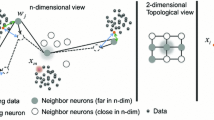Abstract
Self-organizing map (SOM) is a neural network model widely used in high dimensional data visualization processes. A trained SOM provides a simplified data model as well as a projection of the multidimensional input data into a bi-dimensional plane that reflects the relationships involving the training patters. Visualization methods based in SOM explore different characteristics related to the data learned by the network. It is necessary to find methods to determine the goodness of a trained network in order to evaluate the quality of the high dimensional data visualizations generated using the SOM simplified model. The degree of topology preservation is the most common concept used to implement this measure. Several qualitative and quantitative methods have been proposed for measuring the degree of SOM topology preservation, in particular using Kohonen model. In this work, two measuring topology preservation methods for Growing Cell Structures (GCS) model are proposed: the topographic function and the topology preserving map.
Preview
Unable to display preview. Download preview PDF.
Similar content being viewed by others
References
Tukey, J.W.: Exploratory data analysis. Addison-Wesley, Reading (1977)
Kohonen, T.: Self-Organizing Maps, 3rd edn. Springer, Heidelberg (2001)
Ultsch, A., Siemon, H.P.: Kohonen self-organizing feature maps for exploratory data analysis. In: Proceedings of the International Neural Network, Dordrecht, The Netherlands (1990)
Kraaijveld, M.A., Mao, J., Jain, A.K.: A non linear projection method based on Kohonen’s topology preserving maps. IEEE Trans. on Neural Networks 6(3), 548–559 (1995)
Merlk, D., Rauber, A.: Alternative ways for cluster visualization in self-organizing maps. In: WSOM 1997, Helsinki, Finland (1997)
Rubio, M., Giménez, V.: New methods for self-organizing map visual analysis. Neural Computation & Applications 12, 142–152 (2003)
Martinetz, T., Schulten, K.: Topology representing networks. Neural Networks 7(3), 507–522 (1994)
Bauer, H., Pawelzik, K.: Quantifying the neighborhood preservation of self-organizing feature maps. IEEE trans. Neural Networks 3, 570–579 (1992)
Villmann, T., Der, R., Herrmann, M., Martinetz, T.: Topology preservation in self-organizing feature maps: exact definition and measurement. IEEE trans. Neural Networks. 8(2), 256–266 (1997)
Tasdemir, K., Erzsebet, M.: Data topology visualization for the self-organizing map. In: ESANN, pp. 277–282 (2006)
Fritzke, B.: Growing Cell Structures – A self-organizing Network for Unsupervised and Supervised Learning. Neural Networks 7(9), 1441–1460 (1994)
Delgado, S., Gonzalo, C., Martínez, E., Arquero, A.: Visualizing High-Dimensional Input Data with Growing Self-Organizing Maps. In: Sandoval, F., Prieto, A.G., Cabestany, J., Graña, M. (eds.) IWANN 2007. LNCS, vol. 4507, pp. 580–587. Springer, Heidelberg (2007)
Delgado, S., Gonzalo, C., Martínez, E., Arquero, A.: Improvement of Self-Organizing Maps with Growing Capability for Goodness Evaluation of Multispectral Training Patterns. In: IEEE International Geoscience and Remote Sensing Symposium, vol. 1, pp. 564–567 (2004)
Author information
Authors and Affiliations
Editor information
Editors and Affiliations
Rights and permissions
Copyright information
© 2009 Springer-Verlag Berlin Heidelberg
About this paper
Cite this paper
Delgado, S., Gonzalo, C., Martinez, E., Arquero, A. (2009). Topology Preserving Visualization Methods for Growing Self-Organizing Maps. In: Cabestany, J., Sandoval, F., Prieto, A., Corchado, J.M. (eds) Bio-Inspired Systems: Computational and Ambient Intelligence. IWANN 2009. Lecture Notes in Computer Science, vol 5517. Springer, Berlin, Heidelberg. https://doi.org/10.1007/978-3-642-02478-8_25
Download citation
DOI: https://doi.org/10.1007/978-3-642-02478-8_25
Publisher Name: Springer, Berlin, Heidelberg
Print ISBN: 978-3-642-02477-1
Online ISBN: 978-3-642-02478-8
eBook Packages: Computer ScienceComputer Science (R0)




